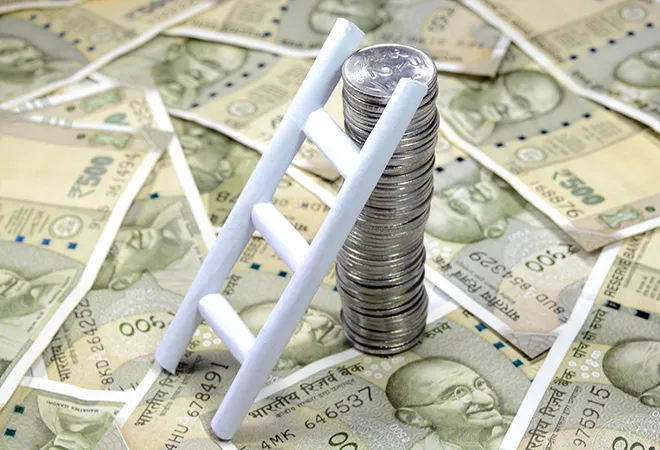-
CENTRES
Progammes & Centres
Location

Both the World Bank and the International Monetary Fund (IMF) have revised their growth projections downwards for India in 2019-20. While the World Bank’s forecast for India’s GDP growth is 7.5 per cent, the IMF’s forecast is a notch lower at 7.3 per cent. The World Bank has pointed out that India’s slow export growth in the past five years has been due to its GDP growth being “too much” driven by domestic demand. Hence its advice for the next government is to focus on export led growth.
The IMF, on the other hand, in its World Economic Outlook released recently has raised the fear of a slowdown in global output growth. Instead of growing at 3.5 per cent as the previous forecast, it is now expected that world output will grow at 3.3 per cent this year. Also, because of the prevailing less favourable climate for world trade today following the big trade dispute between the United States and China, the World Trade Organisation’s (WTO) forecast for world trade growth is lower at 3.7 percent in 2019, instead of 3.9 per cent in 2018.
Slower trade growth has had repercussions not only on the GDP growth of China but on China’s trade partners like India. India’s export growth has not received a big impetus in the last five years while it has been flat in the last one year. Exports grew at 2.44 per cent in February 2019, but it has picked up suddenly in March, to 9 per cent. Nevertheless, India seems to be losing its competitiveness even in labour-intensive goods like garments and light manufactures to countries like Vietnam and Bangladesh.
Slower trade growth has had repercussions not only on the GDP growth of China but on China’s trade partners like India. India’s export growth has not received a big impetus in the last five years while it has been flat in the last one year
The World Bank’s Chief Economist for the South Asian Region, Hans Timmer, has pointed out that it is the strong domestic demand in India which has resulted in the double-digit growth of imports which has led to the widening of the current account deficit. He said that the next government’s focus should be on reducing the stimulus for domestic demand. It should also undertake trade liberalisation on the import side which would create more competition. Export-led growth, according to the World Bank, would lead to increase in productivity. India has been only exporting 10 per cent of its GDP whereas even 30 per cent would be normal.
Today, however, India is facing a slowdown in industrial and manufacturing growth because of the shrinking demand. Various industries from automobiles, scooters and consumer durable goods are facing a decline in demand on the back of continued agricultural distress and slow rise in consumption power which is due to lack of adequate investment in the agricultural sector. Many of the current problems in agriculture relate to poor infrastructure, especially storage and marketing facilities in villages. Improvement in roads, transportation and marketing infrastructure will help farmers realise better prices for their produce and reduce their stress.
The manufacturing sector also needs huge investments in modernisation and innovations of industry as well as physical infrastructure. Thus, the main task before the new government will be to revive industries through higher rate of investment. In March this year, industrial growth has sunk to 20 month low of 0.1 per cent growth. The slowdown in investment is evident in the slow growth of the capital goods industries, which has registered contraction of 8.8 percent in February this year. All these are the symptoms of a deep malaise of an economic slowdown, which is not visible in the GDP figures that are still impressive. India still maintains the tag of one of the fastest growing economies in the world, mainly due to its services sector’s uptick. But with world output growth slowing down, it may be difficult to sustain the momentum.
Reviving export growth is important for boosting industrial growth. But the old export-led growth model of the 1970s is no longer feasible in the world now ridden with widespread protectionism. When the East Asian Tigers experienced rapid export-led growth, the world trade environment was different and China was not such a giant manufacturing hub of the world. Today, many countries, including India, have turned protectionist against the import surge, mainly coming from China.
Reviving export growth is important for boosting industrial growth. But the old export-led growth model of the 1970s is no longer feasible in the world now ridden with widespread protectionism
The World Bank often quotes China’s example of rapid export-led growth. But now China has retracted from such a strategy when it realised the danger of becoming too dependent on the demand coming from the advanced countries. During the 2008 global financial crisis, it faced a slowdown in demand and it gave $586 billion stimulus to revive its economy. China is now trying to rebalance its economy by focusing more on boosting consumer driven economic growth rather than investment driven infrastructure growth which facilitated export growth. China is offering a stimulus package to revive growth through consumer demand which amounts to 5 per cent of the GDP.
India, on the other hand, has to go for investment driven infrastructural upgradation of roads, ports, airports, canals, railways and power which would help in resuscitating our MSME industries, which contribute 40 per cent to India’s exports. Also, India has to fight against non tariff barriers if exports are to take off in a big way. Exporters have been vulnerable to growing number of non tariff barriers in EU and the US. Huge consignments are often rejected on grounds of hygiene and phyto-sanitary measures which have caused ruin to many of our agro and marine based export industries. India has to focus on better quality education and skill development to step up export growth.
Competition should be encouraged but India has to protect itself from unfair dumping of cheap manufactures and agricultural goods from abroad. Protection through higher tariffs has helped the Indian electronics industries in recent times and India continues to protect its agricultural sector quite justifiably.
Financing of exports is a major stumbling block because the Chinese have recently announced a special bank financing facility for the private sector. Indian banks are burdened with huge amounts of NPAs and the banking sector is reeling under its burden. Unless banks, especially the EXIM bank, are adequately recapitalised, the problem of easier terms of export credit will remain a big hurdle to higher export and manufacturing growth.
The views expressed above belong to the author(s). ORF research and analyses now available on Telegram! Click here to access our curated content — blogs, longforms and interviews.

Jayshree Sengupta was a Senior Fellow (Associate) with ORF's Economy and Growth Programme. Her work focuses on the Indian economy and development, regional cooperation related ...
Read More +
David Rusnok Researcher Strengthening National Climate Policy Implementation (SNAPFI) project DIW Germany
Read More +